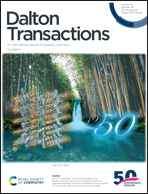An electron-deficient naphthalene diimide-based metal–organic framework for detecting electron-rich molecules through photo-/chemo-induced chromism†
Abstract
A novel naphthalene diimide-based metal–organic framework (MOF) {[Zn(3-DPMNI)0.5(NDC)]·3DMF} (1@DMF), (H2NDC = 2,6-naphthalenedicarboxylic acid, DPMNI = N,N′-bis(3-pyridylmethyl)-1,4,5,8-naphthalene diimide, DMF = N,N′-dimethylformamide), has been synthesized, which shows a 3D pillar-layer architecture built of carboxylate layers and naphthalene diimide pillars. The compound exhibits outstanding photochromic performance due to photoinduced electron transfer (ET) between the electron-rich guest molecules and electron-deficient host framework (host–guest ET). Of note, the host framework of 1 cannot show a macroscopic color change owing to the absence of the ET pathway. Nevertheless, it exhibits discriminative photochromic behavior in the presence of electron-rich solvents, which is mainly attributed to different electron-donating abilities of guest solvents and distinct interfacial contacts of electron donors/acceptors. Furthermore, the MOF can also show discriminative ET chemochromic response to different sizes and shapes of organic amines, which can be potentially used for the visual detection of electron-rich organic amines, especially n-butylamine (n-BUA).



 Please wait while we load your content...
Please wait while we load your content...